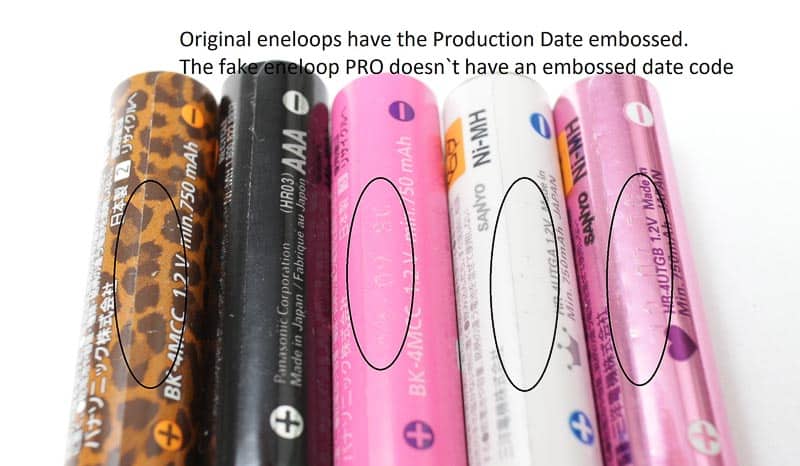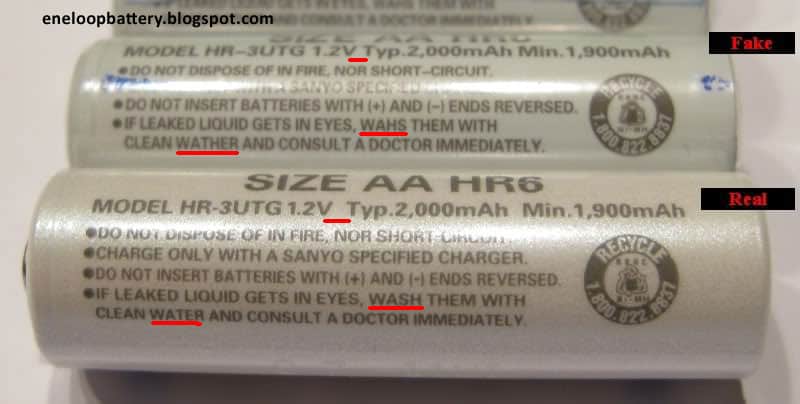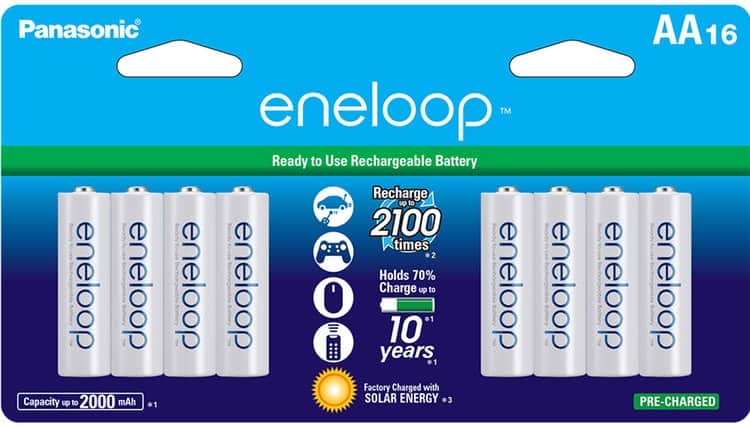FAKE ENELOOPS
Tips to spot counterfeit eneloops
Ever been worried about getting counterfeit Eneloop batteries?
Many people know that Eneloop batteries are the best in the world. And everybody knows that popular products have counterfeits. But YOU don’t want to be fooled do you?
I’ve composed this list to help you watch out for counterfeits, using details that I have gathered from the internet and from my own experience since 2010. And better to be Safe than Sorry! And stay away from eBay Eneloops unless you know the seller.
Where to buy Real Eneloops?
Check out the Eneloop seller’s page for the best deals. Please beware that you shouldn’t buy them from eBay… unless you know enough about Eneloops to know what to look out for.
Fake Eneloop PRO on eBay, Lazada, and Shopee.ph
In the following video I explain over 10 mistakes I found on fake Eneloop packages.
In the other video, you can see some details about the batteries and the test results.
The design of these packages changes over time, and per region. So they may not correspond 100% with yours. But at least you can see what to look out for.\
Fake Eneloop PRO at Shopee
I received an email from a reader in the Philippines who bought Eneloop PRO at Shopee.ph, which are fake. The seller has sold hundreds of packages already. Be warned.
These are pictures of the fake packaging and batteries.



Fake Eneloop PRO AAA
A while ago I received an envelope from Gary from Canada. Inside was 1 AAA Eneloop Pro, with the original package. He ordered a pack of 4 AAA on eBay, but already disposed of 3 that underperformed.
I will show the obvious mistakes with the package as well as the battery itself. I won’t point out every little detail, just a few more obvious ones.
See the front of the counterfeit package here. And see the back of the package here.





Counterfeits from long time ago
Sometimes you can easily see whether something is a counterfeit or not. There have been some very obvious fake batteries out there, that didn’t even need a second consideration to see that they weren’t real. They were mostly sold on Chinese online stores like AliExpress and eBay.
1. Spelling mistakes:
What`s so difficult about copying text?
Well, for some folks it was probably very difficult to copy the text on the battery sleeves.
On the side of every Eneloop, there is some self-explanatory text about the battery. Some people had a hard time getting the spelling right.
They made some easily discernible mistakes. Take a look at these 2 examples
- The word WASH was misspelled with the word WAHS.
- The word WATER was misspelled as WATHER.

This picture was found online, see the stamp in the picture.
2. Wrapper colors
What about White eneloops?
Eneloop uses white sleeves with a blue print. On the positive terminal of a battery is a nipple. Sometimes referred to as the Plus side. Around this nipple there is a paper/plastic washer. This ring has always been white or grey-ish for the white eneloops.
Having any other color they are FAKE
- White eneloop sleeves should be white, and not yellowish white.
- In some instances the washer had a different color , like green or dark gray.
Only limited editions have these different colored washers!

Picture originally found online. It has since gone offline.
3. Shape of the batteries
Whenever you hold a genuine eneloop in your hand and you inspect the fit and finish of the sleeves, the bottom cap, the top cap and the text you can easily discriminate the fakes. Sanyo used, and Panasonic uses distinct materials, with noticeable edges, curves and such. This following example is a clear indicator of a fake cell.
- Near the positive side of the battery there should be no ridge for any batteries produced after 2007. Look at this picture and see for yourself.

Picture found on eneloopbattery.blogspot
4. Wrong stated capacity
Uhmmm.. 2500mAh for a white eneloop?
Keep in mind that all standard eneloops since 2005 have had the capacity for both the AA (1900mAh min) and AAA (750mAh min).
- 2000mAh is the typical capacity of eneloop standard cells. But they usually show 1900mAh only. Any other capacity on standard eneloop batteries are fake.

5. Production-code embossed
The boss is king.
Besides all the above obvious fraudulent sleeves there is yet 1 more specific difference you should be aware of.
While the above mentioned obvious fakes there should be a date code embossed on the side of EVERY eneloop battery, starting from the 1st generation. If your batteries have no Date Code embossed on their side, you have 99,99% chance yours are fake. Production mistakes aside.

Real

Checking fakes by measurement: All generations
1. Checking counterfeits by weight:
Weight is important… not too heavy, not too light
- It is rather easy to put a new sleeve on any kind of battery and let it look like a loopy. It is a bit disconcerting that if you google a little bit you can find wrappers for almost ALL kinds of lithium-Ion batteries out there. Fortunately, I haven’t seen any Eneloop battery wrappers for sale yet.
- But the most difficult way is likely to match their weight.
- From their 1st generation up till the latest Std white AA’s weigh: 27 grams according to their product sheet (actual weight being between 25.8 and 26.0).
- And AAA: 13 grams according to their product sheet (actual weight being between 11.7 and 12.1 grams)
Please check the product sheets in the complete Eneloop line-up. All authentic Eneloop batteries have nearly the same weight with only a minimal variance that most kitchen scales don’t even notice.
2. Check them by voltage
1.2V-1.5V
- Japanese businesses care about details. The Voltage of every new Eneloop battery sold in 1 package should be the same. If you can measure the Voltage and see more than 5% difference you should doubt you got real ones! I would even doubt if there was a 3% difference.
3. Check their capacity
When capacity isn’t the same.
- When you own a battery analyzer like the Maha Powerex MH C9000, Opus BC3100, or SkyRC MC3000, you have the best tool to test whether you have counterfeit batteries if all the above ways fail.
- Of course, this will only help if you already bought them. Right out of the package they should have a very very close mAh discharge capacity.
- When you recharge them and do another discharge test, you should again have very close numbers.
4. Do a Self Discharge Test
(the number 1 counterfeit test)
Consistency is the key
- This is the best test when it comes to identifying counterfeits. If you still doubt with the above information whether you have counterfeits or not, you have 1 more option, and this will clearly tell, by all means, that you have legitimate Eneoop batteries.
- Discharge and charge your batteries maybe 2-3 times and let them sit for 3 months. Then do again a discharge test and see if the capacity is still very close among all cells. They have a very Low Self Discharge and are KING OF THE HILL.
- Eneloop batteries should always have very close numbers amongst cells from the same package. Weight, Voltage, and Capacity.
Some misconceptions:
I have come across a few misconceptions when it comes to distinguishing fake from authentic ones. Here are a few misunderstandings.
Packaging differences
Misconception: Triangular Punchouts are fake
- Of course, there can be said a lot about packaging when it comes to identifying fake Eneloops. But there are some misconceptions about certain types of packaging. Some people say that packages with triangular punchouts are fake.
That is not true! See Panasonic’s own store in Canada for example. They show 2 triangular punch-outs.

Venting holes on AA batteries
Misconception: Eneloops with venting holes are fake
- Eneloops come with venting holes in the nipple at the positive terminal. The 4th generation AA std and 2nd gen lite do not have visible venting holes. PRO AA on the other hand does have visible venting holes.
- Probably all AAA batteries have visible venting holes. Panasonic says they always have venting holes, just not always visible. When they are not visible, they should be present under the washer near the positive terminal.
My advice:
Know the seller!
- Buy from a reputable seller in your country!
- Only buy from overseas seller if you know them, and trust them.
- I recommend not to buy from Asian eBay sellers, other than Japanese.
- Stay away from eBay sellers: 2009china*electronic and 2017china*electronic
Read reviews…
- If a seller sells fake Enloops, you should hopefully be able to read that in the reviews.
- But I agree that most of the people that write a review won’t know how to distinguish the difference between a fake and real Eneloop.
- So if you ever buy fake ones, mention that in the review you publish on their store
Don’t just trust the pictures
- Sellers usually use product pictures that they didn’t take by themselves. So be careful to judge from product pictures alone.
- Ask the seller to take some pictures if you really want to be sure.
- Check out my Facebook page and ask if you are doubtful



